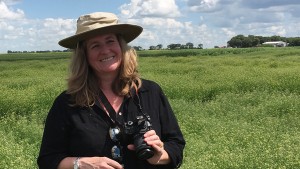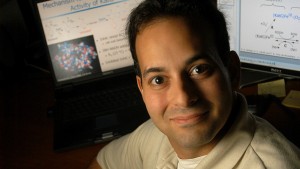In 2017, seven more NC State projects will receive support from the Chancellor’s Innovation Fund (CIF). The funding will help researchers move innovative discoveries from lab bench to the marketplace, in areas ranging from the development of new antibiotics to the creation of faster, more accurate medical diagnostic tools.
This is the sixth year of the CIF. Over its first five years, the fund awarded $1.9 million to 28 projects. That investment in NC State innovation has led to the creation of 10 startup companies, 14 commercialization agreements, $9.9 million in follow-on funding to support further development and $983,000 in licensing revenue. The CIF is managed by the Office of Technology Commercialization and New Ventures, which works alongside university inventors to realize NC State innovations.
This year’s CIF winners are leading innovative projects that aim to turn blue-sky ideas into bold solutions and real-world products.
Making Medicines From Microbes
Chemist Gavin Williams wants to turn E. coli microbes into antibiotic-producing factories.
Scientists can genetically modify microbes to produce specific drugs by inserting different gene combinations into the microbes and then testing the results. With all of the genetic pathways and interactions involved, this can result in literally millions of variants that need testing — a process that is currently too time-consuming and costly to be effective.
Williams has developed a fluorescent biosensor that is inserted into genetically modified microbes to help researchers locate the needle in the microbe haystack. When the drug or molecule of interest is detected, the biosensor lights up and the scientists have a much smaller pool of candidates to test. This new technology will allow scientists to quickly create and test new antibiotics that may be more powerful, with fewer side effects, than those we currently have.
A New Breed of Crops
Chemical engineer Chase Beisel and plant biologist Heike Sederoff have found a better way to genetically engineer crop plants.

Traditionally, genetically engineering plants was too labor intensive to be useful and only possible in a few crops. But Beisel and Sederoff’s new plastid engineering technology can be used on major crop plants like corn or rice to improve desired traits like pest resistance or improved yield. By introducing genes into plastids — specialized structures within the plant’s cells – the genetic modifications can’t spread to other plants through pollen. Better yet, the method is fast, inexpensive and useful for engineering plants that produce specific proteins for applications ranging from plant-based vaccines to industrial enzymes.
Fast, Accurate, Portable Diagnostics
Researchers in NC State and UNC-Chapel Hill’s joint biomedical engineering department have developed a more effective and less expensive tool that can be used to move tiny volumes of fluid through so-called microfluidic devices. Their technology makes portable “lab-on-a-chip” devices a more feasible option for quickly and accurately diagnosing patients based on small fluid samples.
The researchers — Frances Ligler, Glenn Walker and Brian Cummins — will use the CIF funding to demonstrate that their technology can increase immunoassay sensitivity tenfold and reduce the time needed to conduct the assay threefold. The team will also work with potential licensees to develop and demonstrate prototypes that meet industry-specific requirements.
An Overcoat for Infections

New anti-infective coatings that are activated by light could help protect surfaces in hospitals, food processing centers, wastewater treatment plants and daycare facilities. The low-cost coatings are made from engineered plant cellulose nanofibers that have light-sensitive molecules embedded in them. When activated, these molecules inhibit the growth and spread of harmful bacteria, fungi, viruses and parasites. One potential application for these coatings is in health care, where 1.7 million hospital-acquired infections result in nearly 100,000 deaths and $30-45 billion in additional health care costs each year.
The coatings were created by researchers Reza Ghiladi in the Department of Chemistry, Dimitris Argyropoulos in the Department of Forest Biomaterials and Frank Scholle in the Department of Biological Sciences, and can be applied to existing materials without contributing to drug-resistant superbugs.
Sticky ‘Gecko Leg’ Particles
Orlin Velev, INVISTA Professor of Chemical and Biomolecular Engineering, has developed a new process for taking almost any polymer and converting it into extremely sticky particles while dramatically increasing its surface area. The patent-pending process does this without changing the chemical properties of the polymer. When dried, these particles can also be tweaked to make coatings and nonwovens that are very adhesive and able to either repel or attract water. He calls these modified polymers “gecko leg” particles, as their surfaces mimic the sticky legs of the lizard that are able to cling to almost any surface.
The gecko leg particles have potential applications in areas ranging from cosmetics to agriculture, nonwoven materials, adhesives and paints. The CIF funding will allow Velev’s team to scale up the process, make samples of the novel particles with a variety of properties and establish collaborations with industrial partners to move forward with commercialization.
Locking Away Business Logic
In the software world, “business logic” is the term for computer code that translates real-world business rules into often complex calculations and rules. This business logic allows software to perform functions such as formulating price quotes for potential customers. Companies want their employees and customers to be able to use this software online, but they don’t want to expose so much of their business logic that it could put them at a competitive disadvantage. This is where NExS comes in.

NExS allows businesses to design and maintain their business logic using conventional spreadsheet tools (such as Excel), but also deploys that business logic as a modern web or mobile application. The spreadsheet containing the business logic is never exposed to the end user, limiting any potential security concerns. The project is helmed by Tom Miller, the McPherson Family Distinguished Professor of Engineering Entrepreneurship, and computer science researcher John Bass, who have developed a fully functional prototype of the system. They plan to use the CIF funding to fine-tune the program and make it more user-friendly.
Overcoming the Digital Divide
More than two billion people worldwide who don’t have internet access often miss out on life-changing benefits of being connected, such as automated micro-lending for entrepreneurs, marketplace applications and information services including weather forecasts and market pricing. To help overcome this digital divide, NC State innovators have developed a new platform that enhances the capabilities of cell phones with text-messaging services, which are common even in disadvantaged areas.
NC State’s enhanced Short Message Service (SMS) platform overcomes a limitation of texting technology: all SMS messages are independent of each other. Human language is used to create meaning from SMS conversations between people, and it is difficult to program computers to accurately communicate with humans over SMS. Solving the problem would enable international aid organizations, social science researchers, microfinance organizations and e-commerce groups to reach unserved people around the world.
The research team includes computer science researcher John Bass, who has 20 years of experience in system design and project management; Duarte Morais in the Department of Parks, Recreation and Tourism Management, who has 15 years of experience with global economic development and micro-entrepreneurship; and Ryan Kilby, a computer science expert who has experience developing complex web apps for customers.



